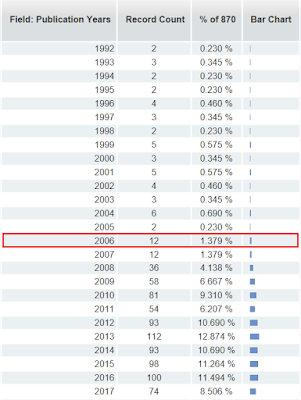Nobel laureate Paul Crutzen 2006, conceptualised geoengineering as an 'escape route' from climate change, particularly, stratospheric aerosol injection. (Fig.1) Fuelling the divide further between anti- and pro-. This post outlines the benefits and costs of deploying SRM.
 |
| Fig.1 Screen capture analysing the total publications with 'geoengineering' in its title (source: Web of Science [Last accessed: 11/10/17]). |
Why?
In 2010, the International Risk Governance Council stated that an 80% reduction in CO2 emissions is required to avoid drastic climate change, (a report today shows increasing CO2 levels in China and India). In comparison, SRM approaches only require a small increase in the proportion of solar radiation reflected into space to significantly cool temperatures over a short period of time (Table 1), but it does not tackle the root cause of climate change, or, ocean acidification, only warming and thus often branded as a 'last resort'.
Table 1 Summary of SRM approaches taken from Calderia et al. (2013)
The quick deployment, high cooling, low cost and medium risk of stratospheric aerosols has incentivised research.
SRM method
|
Maximum cooling potential a
|
Attainable speed of deployment b
|
Relative cost per unit effect c
|
Relative risk to environment per unit effect d
|
Selected references
|
Space-based schemes
|
High
|
Slow
|
High
|
Low
|
Angel 2006, Early 1989
|
Stratospheric aerosols
|
High
|
Fast
|
Low
|
Medium
|
Budyko 1982; Rasch et al. 2008b, 2009; Robock et al. 2008
|
Whitening of clouds
|
Medium
|
Fast
|
Low
|
High
|
Latham et al. 2008, Rasch et al. 2009
|
Whitening of the ocean
|
Medium
|
???
|
???
|
???
|
Pres. Sci. Advis. Comm. Environ. Pollut. Panel 1965, Seitz 2011
|
Plant reflectivity
|
Low
|
Medium
|
Medium
|
High
|
Doughty et al. 2011, Ridgwell et al. 2009
|
Whitening of built structures
|
Low
|
Medium
|
Medium
|
High
|
Akbari et al. 2009, Menon et al. 2010
|
The quick deployment, high cooling, low cost and medium risk of stratospheric aerosols has incentivised research.
The case of stratospheric aerosols
Studies suggest that injection of sulphates into the atmosphere aids in the destruction of the ozone layer, enhancing incoming solar radiation, warming the planet and effecting public health. However, this is a short-term issue that is resolved over time as fewer chlorofluorocarbons (CFCs) can react with ozone particles. Using alkaline aerosol (calcite) in geoengineering could cool the planet whilst repairing the ozone layer, by neutralising acids from anthropocentric emissions. SRM could ensure the Earth remains below the agreed 1.5o C in Paris, and prevent sea level rise this century, saving coral reefs and halting the displacement of populations.
Another poignant argument against stratospheric aerosols is the promoted consequence of acid rain. The effects are robust in research, especially concerning the reduction and termination of freshwater fish populations, lake bacteria and causing forest dieback which in turn reduces food supply affecting forest bird communities. However, globally acid rain increase from sulphate aerosols is likely to be a moderate price to pay for global cooling, but, this depends on the amount of sulphur introduced into the atmosphere and amount converted into sulphuric acid. Using alkaline aerosols, as supposed to sulphates would also avoid this issue whilst simultaneously cooling the planet.
Another poignant argument against stratospheric aerosols is the promoted consequence of acid rain. The effects are robust in research, especially concerning the reduction and termination of freshwater fish populations, lake bacteria and causing forest dieback which in turn reduces food supply affecting forest bird communities. However, globally acid rain increase from sulphate aerosols is likely to be a moderate price to pay for global cooling, but, this depends on the amount of sulphur introduced into the atmosphere and amount converted into sulphuric acid. Using alkaline aerosols, as supposed to sulphates would also avoid this issue whilst simultaneously cooling the planet.
The natural analogue for aerosol injection has been seen to have had no effect on climate other than reducing global temperatures. However, studies indicate that volcanic eruptions in the tropics induce changes in atmospheric circulation, warming continents in the Northern Hemisphere. Whilst eruptions at high-latitudes weaken the Asian and African monsoons by reducing precipitation over continents that subsist to stay alive, ie. Laki fissure, Iceland eruptions from 1783-84 caused famine in Africa, India and Japan. A global release of stratospheric aerosols will be problematic, but Scientists in 2007 released simulations of aerosol injection over isolated regions (the Arctic), this, however, would still reduce precipitation over wide regions and succumb populations to drought and climate variability.
Contentious ethical issues arise concerning SRM. The unilateral implementation of this method creates apparent winners and losers. The issue of governance and who calls the shots? is critical, SRM may induce conflict or the 'weaponising of nature' (Geostorm film).
Conclusion
The cooling capabilities of SRM are enticing despite the implications it may have on earthly systems. Alan Robock (2012) states:Testing of geoengineering should be indoors for the foreseeable future, either in computer models or laboratories, without potential to affect the environment. Only once we feel that we have developed a good understanding of a potential system and have devised an outdoor test that is crucial, should it go ahead - pg204In contrast, I believe SRM will be implemented overtime. The potential to halt sea-level rise and global warming may change perceptions on SRM to save key habitats of magnificent species like the polar bear. However, SRM should not be viewed as an 'easy fix', we must continue to change global consumption patterns and energy infrastructures the tipping point.
.
I only see SRM working properly under a utilitarian power, leaving me with conflicted feelings over who the winners and losers are. Should we really have all this power?

.png)






No comments:
Post a Comment